From horseless carriages to self-driving transports, the past century-and-change has seen cars in every imaginable size, shape and form. But during that time there have been only a few vehicles that have transcended automotive history and entered into cultural history, making them iconic cars.
Status is by and large subjective, but there’s no arguing that these automobiles are as recognizable – both by name and design – and influential as any other four-wheelers that have crossed our paths.
Ford Model T
It’s impossible to formulate a list of the most iconic cars in history without starting off with the Model T. Henry Ford’s creation went beyond transforming the nascent automotive industry: It also had an indelible effect on American society.
First sold in 1908, the Model T was not the first automobile available for purchase in the U.S. It was, however, the first that most people could afford to buy. By revolutionizing mass production through assembly line manufacturing, which substantially lowered the cost to make the car, Ford was able to sell the Model T starting at $260, roughly $8,000 today. By the 1920s, more than half of the world’s registered automobiles were Fords. Closer to home, mass ownership of the vehicle helped connect rural Americans to the rest of the country and eventually led to the introduction of the numbered highway system.
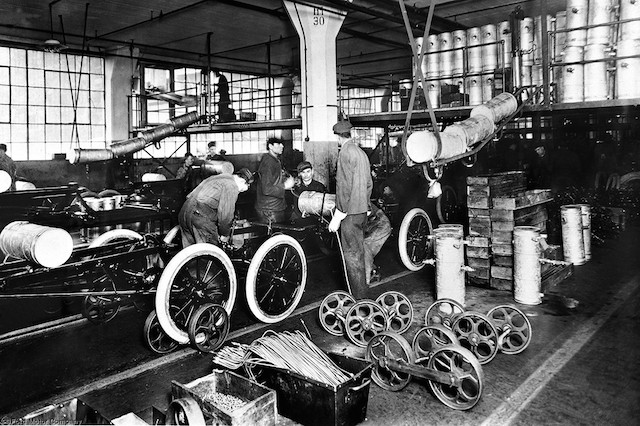
The Model T was more than just the first mass-produced car. It was also revolutionary as an automobile in and of itself. It was the first to have a steering wheel on the left side (previous models had it in the center) and to offer a windshield. That’s not all. According to the Ford Motor Company, “The vehicle was also the first to have its engine block and the crankcase cast as a single unit, the first to have a removable cylinder head for easy access, and the first to make such extensive use of the lightweight but strong alloy known as vanadium steel.”
One characteristic the Model T is often thought to have lacked is color. It’s commonly believed that the vehicle was only offered in black. However, this was only true from 1914-1925. Before and after that time, it was available in several different colors including blue, red, grey, and green.
Ford last made the Model T available in 1927, replacing it the following year with the Model A. All told, more than 15 million Model T’s were sold.

Ford F-Series
If you stick to the roads of the Northeast you may be surprised to learn that the Ford F-Series is the best-selling vehicle in the country – and has been for decades. The truck is the most popular car in a majority of states, including nearly every one in the South and Midwest.
A few years after Ford debuted the Model T, customers began asking for a vehicle capable of hauling heavier loads to help them with work and deliveries. The company responded with 1917’s Model TT, which had the Model T’s cab and engine but a heavier-duty frame.
Following decades of commercial use, the first consumer F-Series debuted in 1948. “After the war, a lot of rural Americans moved to urban and suburban centers looking for work, and many took their Ford pickups with them,” said Ford historian Bob Kreipke. “Ford saw this as an opportunity, and began work on the next generation of trucks for 1948, what came to be known as F-Series Bonus Built trucks.”
Over the decades, the truck merged its utilitarian nature with improved aesthetics and creature comforts like two-tone paint, automatic transmissions, armrests, sun visors and improved heater and radio. It soon became a vehicle that fit in just as well on the farm as it did on Main Street. Today’s F-Series trucks are nearly as luxurious as any luxury car – but far more popular.
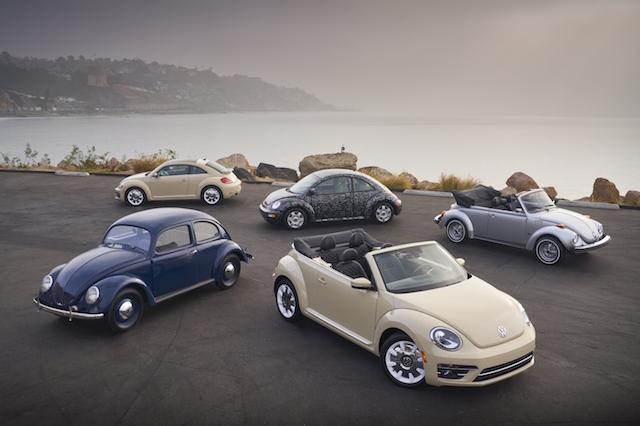
Volkswagen Beetle
There is not a more recognizable car in automotive history than the Volkswagen Beetle. Behind that famous bulbous shape is a fascinating story filled with twists and turns. Ironically, although it rose in prominence in the U.S. during the flower power days of the 1960s and ’70s, the car was first commissioned by Germany in the lead-up to World War II. The vehicle was meant to provide German citizens with transportation much like the Model T did in America, but as the war ramped up, production was put on hold.
The first Beetle exported to the U.S. arrived in 1950 and by 1968 America had become Volkswagen’s largest foreign market, accounting for 40 percent of the company’s produced cars. The Beetle’s unique shape – designed by Porsche founder Ferdinand Porsche – and bright colors attracted Americans looking to bask in the post-war glow. It remained popular when drivers began buying smaller, more compact vehicles and got a cultural boost when the car was featured prominently in Disney’s “The Love Bug.” In 1972, the Beetle passed the Model T as the bestselling car of all time.
In the 1990s, Volkswagen unveiled a sleeker, modernized version of the Beetle. This model was sold for the next 20 years until the marquee ceased production of the Beetle in 2019.
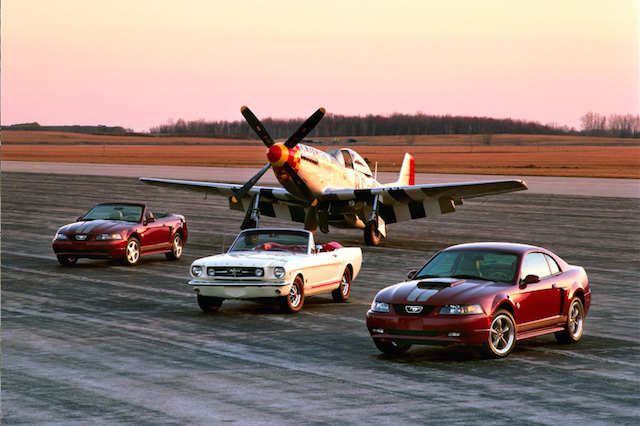
Ford Mustang
The mid-20th century was an exciting time for automobile enthusiasts. It was during this period when the idea that cars could be more than just a mode of transport – namely, they could be stylish – took hold.
Ford Motor Company took that concept to a new level when it unveiled the Mustang at the 1964 World’s Fair. The vehicle’s debut was featured on the covers of Newsweek and Time magazines. The publicity worked. With its long hood and short rear deck, the world’s first pony car had a look unlike any other, and consumers lined up. In its first year, the Mustang sold 400,000 units; in the first three years, 1.7 million. This made the Mustang Ford’s most successful vehicle since the Model A.
In case it needed more of the limelight, a green 1968 Mustang 390 GT was famously featured in the movie “Bullitt,” starring Steve McQueen. This helped launch the coupe from popular car to cultural icon.
Today, the Mustang remains as popular as ever. It has been the world’s best-selling sports car each of the past seven years.

Toyota Corolla
The Toyota Corolla is so ubiquitous on American roadways that it’s seen more as an everyday vehicle rather than an iconic car. But it’s precisely that popularity that makes the Corolla one of the most iconic cars in history.
At the time the Corolla was first produced in 1966, car ownership in Japan was still something the general public aspired to. Toyota allowed them to reach that goal by creating a car designed as not just a utilitarian form of transportation, but something owners could be proud of, while still being affordable.
“The market has demanded attractive vehicles – vehicles that don’t seem inferior when compared to others and even appear somewhat luxurious” said former Corolla development leader Tatsuo Hasegawa. As such, the car was given great attention to detail and came equipped with new technology and innovative features only seen in higher-end vehicles. These included a revolutionary engine, floor-mounted gear lever, separate bucket-type front seats, armrests, as well as a center console box, radio and heater.
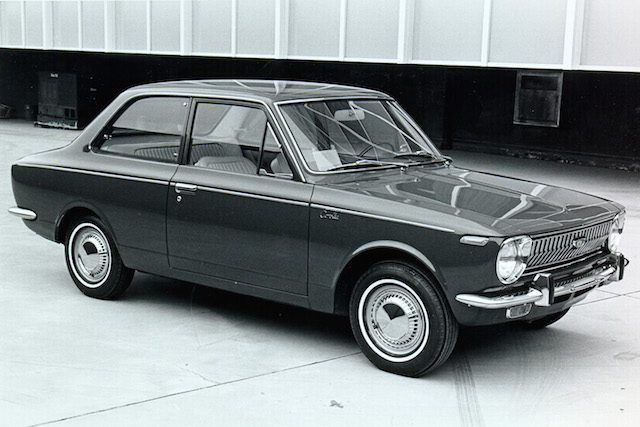
The Corolla also holds an important place in American automotive history. The car was first introduced stateside in 1968 and became the first Japanese automobile to have a major footprint in the United States. Today, America imports more cars from Japan than nearly any other country, roughly $30 billion worth.
As you can observe on your daily commute, the Corolla is still around and still very popular. Through half a century and 12 model generations it has become known as the epitome of automotive efficiency and reliability. That has translated to sales of more than 50 million, making the Toyota Corolla the best-selling car of all time.
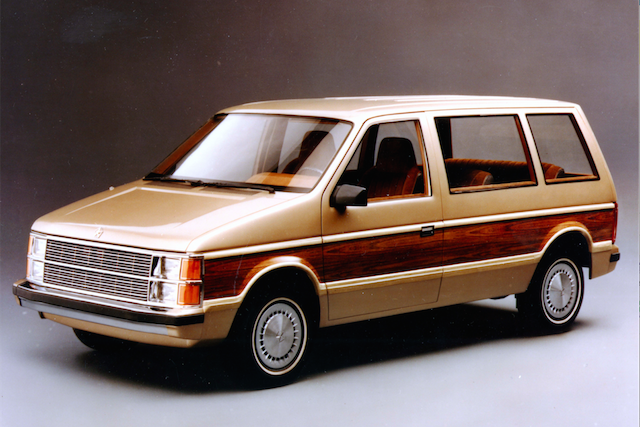
Chrysler Minivans
The minivan may not be the sexiest automobile in history, but when they were unleashed onto the public, these family mobiles were downright revolutionary. A van that could drive and handle like a consumer car was an idea that had never been broached.
In the mid-1970s, Ford Motor Company president Lee Iacocca felt the brand needed a family van model. A team of engineers developed a prototype, which Iacocca kept hidden out of fear that the project would get killed off my his boss, Henry Ford II.
A few years later, Iacocca left Ford to join rival Chrysler and was allowed to take his minivan idea with him. By 1983, the idea had finally come to fruition and the van was ready. Sold under two monikers, the Plymouth Voyager and Dodge Caravan, the vans were an immediate hit with consumers, selling 290,000 units in the first year. People loved the extra cabin room, sliding door, and car-like maneuverability. It was particularly popular with suburban families who could drive their kids around in one vehicle and still be able to fit that vehicle in their home garage. In no time at all, Chrysler had created a new segment in the auto market and other manufacturers followed suit, creating their own van models.
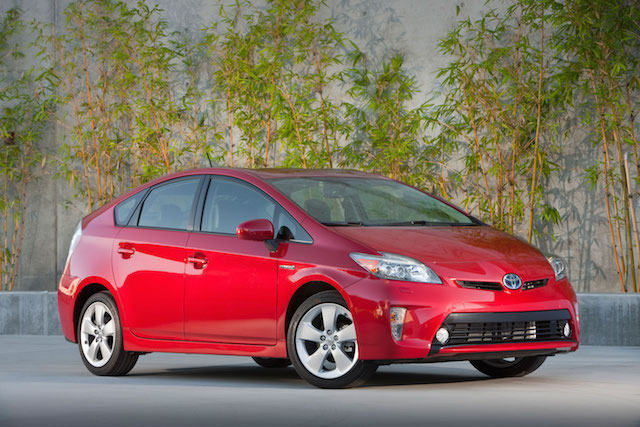
Toyota Prius
Electric vehicles are the wave of the future and it may not be long before they’re the only cars on the road. It may be difficult to imagine a time without clean-energy cars, but it wasn’t all that long ago – and it was the Prius at the helm of ushering in the automotive trend.
In the 1990s, Toyota set its sights on developing cars with better fuel efficiency. The result was 1997’s Prius, which first reached the U.S. in 2000. The car’s hybrid power system utilized regenerative braking that converts energy into electricity. Interestingly, the futuristic first-generation model was not a hit. Toyota’s designers went to work and came up with a completely redesigned Prius in 2003. The car got boasted an Environmental Protection Agency-estimated rating of 46 combined mpg.
The Prius exceeded expectations by selling hundreds of thousands of units internationally and quickly became one of the most talked about cars on the market. As time went on and climate change became more of a concern, the vehicle grew in popularity to the point where there was a waiting list just to buy one.
Now up to an estimated 58/53 mpg, the Prius remains one of the bestselling hybrids. Toyota has since introduced a plug-in hybrid model capable of 133 mpg equivalent.

Tesla Sedans
While Prius created the electric vehicle market, Tesla has taken it by storm. It started in the early aughts when a team of engineers formed Tesla, Inc. and set out to produce an electric vehicle that could not only meet the performance and capabilities of gas-powered cars, but surpass them, all while producing zero emissions.
Their first attempt was the Roadster sports car, which in many ways was an incredible success. It achieved 245 miles on a single charge, an unheard of range for EVs at the time, accelerated from 0 to 60 miles per hour in less than four seconds and reached a top speed of 125 mph. But with a price tag north of $100,000, the Roadster was prohibitive to most customers.
The team went back to the drawing board and in 2012 unveiled the Model S, which immediately raised the EV bar. According to Tesla, the sedan boasted “the longest range of any electric vehicle, over-the-air software updates that make it better over time, and a record 0-60 mph acceleration time of 2.28 seconds.” Just three years after its release, the Model S was already the top-selling battery electric vehicle.
The only thing that threw the car from its throne was Tesla’s release of its Model 3. In 2018, its debut year, the smaller, less-expensive sedan moved 140,000 units – and the pace hasn’t slowed. Although it’s been around for less time than most of its competitors, the Model 3 has quickly outpaced the market and is currently the best-selling battery electric vehicle of all time with more than 1 million cars sold.
Tesla also produces two crossover models, the X and Y, but it’s the company’s sedans that remain most popular and iconic.
Have you driven any of these cars? How was the experience?
What other cars deserve a spot on this list? Let us know in the comments below!
104 Thoughts on “The Most Iconic Cars in History”
Leave A Comment
Comments are subject to moderation and may or may not be published at the editor’s discretion. Only comments that are relevant to the article and add value to the Your AAA community will be considered. Comments may be edited for clarity and length.

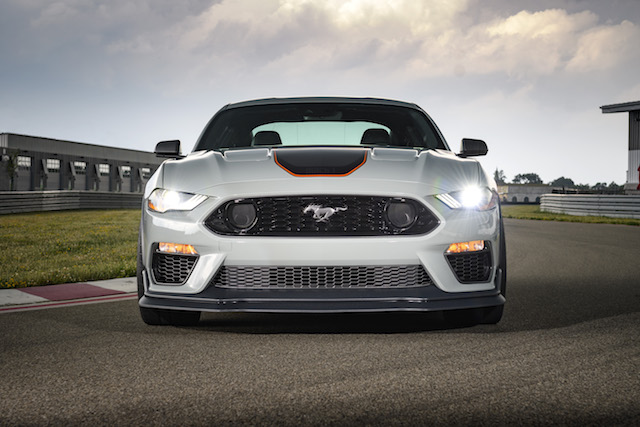
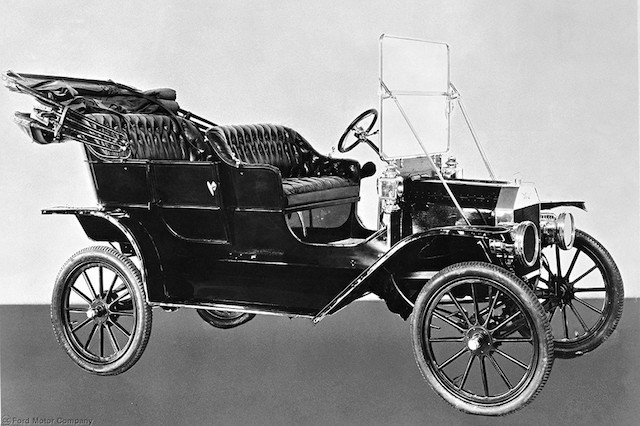


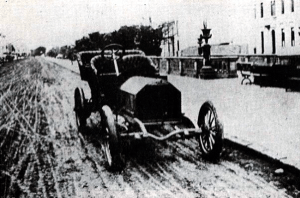











I grew up in a Studebaker dealership. I was surprised that you failed to mention that Studebaker was also at the forefront of the mobil industry starting with making the Connestoga wagons which forged the way to the west by the pioneers, and then their first cars were ELECTRIC AUTOMOBILES in 1902.
“The first Studebaker automobile made its debut in 1902, and the company produced a line of great looking electric-powered vehicles which many consumers admired”. All the way to the exceptional, and fast, AVANTI.
I now have a 1962 Gran Turismo Hawk.
Not complete without the 1953 Corvette!
The car the personified the muscle car era–the Pontiac GTO. They put a big engineer in the Tempest model in 1964 and voila, the Gran Turismo Omologato was born. I got a 1968 model, the year before they came out with the “Judge”, which my buddy got. Might not have been the fastest muscle car but by far the coolest.
When I got my driver’s license my parents owned a ’64 mustang. Oh how I loved to drive that car! It was a dream to drive, it was fun, it was status with the guys; what more could you ask for? My dad loved it so much he drove it til it was literally falling apart. What was’t to love, the styling, that big sports steering wheel, the handling! When I got my own first car I got a used Olds Cutlass. Not that it wasn’t a good car (my dad who had car “connections” locally found it for me and it was great and beautiful, but so big!) When the Olds went, I switched to driving my now husband’s VW Rabbit. Something totally new. a new feel, a whole new experience these cars had. If you were looking for a smooth, whisper quiet ride this was not your car. Still, it was very serviceable auto and I loved it. But my real passion now is VW Beetles. I have owned my current one since 2010 when I got it new, and it is running just fine, better than ever! You want a solid car, VW offers it. Had a bug before this one too. It is such a fun car to drive, handles so well, great turning ratio, and just plain fun. I went into mourning the day VW said they would stop producing it! Still don’t understand it as it is such a popular car. I am still holding hope they will bring it back. My 2010 Beetle is running just swimmingly, and I have no need to trade it in now, what with its low mileage. I mostly use it now zipping around town and nearby my hometown. We did take it on a vacation roadtrip this year, which was unusual, but it is running so much better than my husband’s Chevy, it made sense, small or not. And it performed like a champ! I tell you, if they ever do bring it back, I will never drive another car!
You left out the Yugo!
It’s not completely off our radar: https://magazine.northeast.aaa.com/daily/life/cars-trucks/auto-history/the-worst-cars-in-history/. It’s iconic in its own way! 😉
Electric is ok, but don’t we use fossil fuels to generate electricity?
How does that help environment ?
Agree Corvette should be incl. but hard to incl. all the great cars. Article a little Ford heavy, but maybe for good reason. Henry Ford did alright, & Lee Iacocca too. (I believe he was in on the beginning of the Mustang as well as the minivan.) Minivans can’t do a lot of stuff trucks can do, but they’re a lot more comfortable and versatile. SUV ? Huh. Can you say “rollover. I absolutely would have on that rollercoaster ride to Wayne, Maine ! Want to call me a ” soccer mom” ? Go right ahead, show off your ignorance. By the way, SUV’s are just station wagons on 4wd chassis. Ouh yuk !
Of these iconic cars, I have owned a 1966 Ford Mustang, 289 c.i, V8 automatic, convertible; a 1967 Volkswagen Beetle with a 4 speed stick shift and crank-open sun roof; a 1970 Toyota Corolla; and a 2003 Toyota Prius. I loved them all but have to say that my all time favorite was and still is the 1966 Mustang. It was my very first car and was a lot of fun to drive. A real head-turner even in today’s market!
Ho w can you not include the Jaguar E type (xke) SURELY ONE OF THE MOST ICONIC CARS OF ALL TIME
Back in the fall of 2001, I bought a Corolla S. I still have it. It’s the most mechanically perfect car I ever had. It drives as well as when I drove it out of the showroom. It’s incredibly reliable. It handles like a sports car. It’s quick and nimble. I started driving in 1971 and it puts all the other cars to shame. Love my Corolla.
For beauty: 1957 Ford Fairlane 500 hardtop, especially in black and yellow!
Don’t blame people for loving sports cars, but some are quite narrow minded. A little Ford heavy, but Chrysler got the last laugh on minivans. I want to talk “revolutionary”. I still have my ’87 Caravan(got it early ’90s). I hate fashion; couple times had guys in suv’s try to shame me, just laugh at their ignorance. Middle seat(2) & rear seat(3)(can also be moved to middle) are self-contained incl. seat belts, easily removable & leave an open, completely flat floor. No lip @ bottom of sliding door opening, as a plumber, I can slide an 80gal. wtr. htr. in box, in the side door & close it ! FAAAR more UTILITY than a “sport utility v.” & FAAAR more sporty, also. (maybe not to look at, but to drive, ABSOLUTELY). Once had the thrill of driving, by myself(so I didn’t have to worry about scaring THE HELL out of anyone), narrow, humpy, winding roads from NH to Wayne, Maine. Very little other traffic, THANK GOD, I often needed a lot more than my ½ of the road. I pushed it as hard as I could, went as fast as I could on those country roads, up shifting and down shifting the manual frequently for miles(hate automatics). I could not believe how it handled; like a sports car. Front WD, the cross member & drive train sit very low up front. These INCREDIBLE vehicles are extremely well designed & well built. The auto REVOLUTION of 1984. THANK YOU LEE IACOCCA !
Inconceivable (yeah, I know about “You keep using that word. I do not think it means what you think it means.”) that nothing in the Jeep line is not mentioned in this article. It is one of the most iconic American vehicles ever.
Oh hell, editing error. Meant to say that “nothing in the Jeep line is mentioned in this article.” Somehow got an extraneous “not” in there.
The Honda CRV should be considered iconic due to its durability, size, and convenience. It may not be the first SUV, but it has continually been one of the best in sales.
I have a 66 Corvette convertible, It will blow away that Mustang. Put a cover over them and the corvette stands out, Beautiful lines.
The most iconic US vehicle is the Chevy Corvette “Stingray”. First fiberglass sports car with racing lines. Internationally, the Jaguar E-Type (XK-E) and the MG TD were iconic world class vehicles….
Mustang is NOT a “sportscar”. Look up the definition: TWO seater. BTW, the best selling sportscar is the Miata MX-5. As others have said, how about the ’57 Chevy BelAir, the Smoky and the Bandit TransAm, the Chevy Corvette , and the ’59 Caddy with the humongous tail fins??? Other than that, I like your piece!
How about the Porsche 911
The Continental Mark II was manufactured in 1956 and 1957. It was the most elegant car of the decade. It was owned and driven by celebrities and world leaders. About 3,200 cars were manufactured.
Civic with a laptop deserves a spot there💀
The Jaguar XKE roadster has to be on the list of iconic cars. (I’ve had mine for 56 years.)
How about the ‘32 Ford Duece Coupe Hot Rod???
They usually chopped and channeled these for the ultimate effect! It was truly Classic….
The Prius iconic? Does iconic now mean annoying, stupid, and ugly?
Where’s the love for the Volvo 240 series?
From the 140 through the 940 series,solid swedish engineering and durability
What about the truly iconic ’56 Chevy?????
These guys have no idea what an iconic car is… Corvette, ya think, DMC Delorean, Camaro, Ferrari 250 GTO, Pontiac GTO, Ford Thunderbird, Shelby Cobra… the list goes on and on. F150 ?
YES to all those wonderful iconic cars!
The DE LOREAN DMC 12 is probably the most iconic car the world has ever seen. Famous? You bet! It’s NUTS not to list it here! And they have a Prius here? My De Lorean has a brand new stage 2 engine with ported and polished heads, road and track cams, twin headers and dual catalytic converters, with a lot more horsepower than stock, idles rough like a funny car etc. It is every bit as exotic as you would expect with a chassis by Lotus. It was designed to resist corrosion and thus reward the customer. And not listing the Corvette is a nuts too. I drove my car into NYC once past NBC studios and TV cameras poked out a Limo’s windows following me about town. I’m no movie star! Hows that for Iconic?! This list is a new car add if you ask me.
There’s 2 big problems with this list. What the author or reader thinks the definition of iconic means. Also, in this subject 10 is just not enough. It is easy for me to agree with the choices, but there a many more just as good or maybe better.
Really the Beetle? How many air cooled rear end cars are on your block? I’d say try a Hemi Dodge Charger Luke.
Really the Beetle? How many air cooled rear engine cars are on your block? Maybe try a Hemi Dodge Charger Luke.
Was this a Ford commercial
so, ford model t, ford f series, ford mustang, hmmm do you see a pattern.
no corvette? shame on you, imports? iconic? i think not.
Prius?! Only popular for a few years. I’d add the Porsche 911.
Prius fits iconic. How many hybrid cars are being made today by other manufacturers? More are comming. Popular may be a reason to push a car in to the iconic category but not always. Take the Crown Vic, a popular car, but certainly not iconic. It was as conventional as you could get, at one time.
Just got home in my ‘63 beetle I’ve had it going on 24 yrs love the car. I can’t go anywhere without peeps stopping to talk to me and telling their stories of the past in a VW bug.
HOW ABOUT HE 64 AND A HALF MUSTANG CONVERTABLE. WE LOVED OURS AND IT WAS ALWAYS THE CENTER OF ATTENTION!
We had a 64 and a half mustang, too Loved it! You’re the first person I’ve ever heard that had one, too. Wish I still had it. I wonder how many were made. Thanks for sharing Cathy H.
The Camaro was a hit right off. Henry Ford II set up a team to design a competitor. The assistant design chief at Aston-Matin headed that aspect. . When the first Mustang was shown at a Detroit area raceway, Lee Iacocca jumped out of his seat, turned to his fellow executive and shouted “We gotta have that car !!” Calmly they told him “Lee. It’s our’s.” That from the executive who headed the whole secret development…The late “Cog” Briggs.
No more lists please! They never get it right! C’mon, no Corvette? Geesh.
The mustang over the GTO, the progenitor of the muscle car movement? John DeLorean is rolling over in his grave right now.
And what about the 57 Chevy Bel Air. I would suggest that maybe this should be a top 20 list. Lol
Does no one consider the Ford T- Bird from the fifties iconic even though the more recent remake may not have been as big a success?
Lots of good suggestions, most of which are more worthy than some of the examples in the article. I’d also suggest adding the Mazda Miata (certainly over the Corolla)
I’m surprised-not a mention of the beautiful “57 T-Bird”! A one of a kind Icon! I guess if your under 60 you don’t remember ?I
Regarding SUV’s, the 1935 Chevrolet Carryall Suburban was Americas First SUV. However, some often credit the 1984 Jeep Cherokee (XJ) as the first SUV. However, let’s not forget the Chevy K-5 Blazer, Ford Bronco, Toyota Landcruiser and many others…
I really meant crossover SUV, not one built on a truck frame. Certainly, there were earlier ones, such as the AMC Eagle, but the RAV4 is the one that expanded the market.
This list blurs the line between iconic and important. But if you are going to do that, then the Toyota RAV4 deserves a spot on this list. It was the 1st SUV, and as everyone knows, SUVs are everywhere now.
The 2015 Camaro 2SS Commemorative edition is awesome vehicle I love it. You missed the Camaro altogether.
67 VW Karmin Ghia classic. 58 Isabella Borgward. my favorites.
An old boyfriend of mine owned and loved his Karmin ghia. It was a cute little car, but I had to push it plenty of times!!!
No Corvette? No Porsche 911? No BMW 3-Series or MBZ S-Class? No Jeep? These are industry defining steeds. True, the Chrysler Minivan created a new segment but the Corolla remains one of the most non-descript “econoboxes” ever produced. The Honda Accord would’ve been a far better choice.
Mini Cooper, European car of the 20th century. Mercedes 300 SL gull wing, Studebaker commander Starliner 1953, selected by MOMA as one of the world’s 10 best postwar designs.
How can you make a list of the most iconic cars without mentiong the Jaguar E Type (XKE). Enzio Ferrari called it the most beautiful car ever built.
That’s pretty much the opposite of iconic. 9/10 people won’t be able to identify those.
Amen
Abigale Beecher would agree!
The Corvette for sure. However if you want to add more try the 1964 Pontiac GTO. It started the muscle car era and was slipped in under the noses of the GM executives. They didn’t write songs about most of the cars you list.
No list of “iconic ” cars is complete without mention of the Porsche 911. In continuous production for nearly 60 years, there is just no substitute.
If you are a car enthusiast,every car manufacturer has produced an iconic vehicle.
Very thoughtful list. Sure, there are other candidates, eg Roller or Bentley as icons of luxury, but this list covers more interesting bases. The only mildly interesting thing about a Corvette is its fiberglass body and styling. Otherwise it’s just a muscle car, and the Mustang is already on the list. Corvette lovers will flame me for this…..
By definition, Corvette is not a muscle car, it’s technically a sports car. Muscle cars normally have four-seats, and are straight-line racers. Sports Cars emphasize handling, are usually 2-seaters, although can have a small rear “child’s” seat.
I think the Jeep Cherokee deserves a mention. It ushered in the SUV era which we are now in the midst of.
You can produce electric cars that out perform gas powered cars but unfortunately the sound and feel is not there especially in sports cars. Personally I care about performance but a vehicle has to look good as well. The Tesla dashboards look like a laptop, nothing like the dash of a Triumph TR6 from the 60’s. Sure some of those vehicles had their problems but they had class which most vehicles today lack. Give me a 63 split window Corvette, 64 Jaguar XKE or 65 Shelby Cobra.
A minivan, a Corolla, a Prius and no Porsche 911, not Shelby Cobra?? Must be smoking some good stuff.
The Chevrolet Corvette has been in production for 68 years, since 1953 and it didn’t make the list? In its current mid-engine form, its won countless awards including MotorTrend Car of the Year, Car & Driver 10 Best, Edmunds Best, North American Car of the Year, Free Press Car of the Year, MotorWeek Best of the Year, Automobile Magazine All Star, Popular Mechanics Car of the Year, Ward’s Auto Best Interior…
Datsun 240Z?
Is this a paid advertisement?
How could you not include corvette in this list?
They have been made nearly every year since 1953!
What about the GTO? It marked the beginning of the muscle car era. The GTO is the quintessential muscle car.
I thought I’d see a Corvette! My husband and I each have one.
How is the 1957 Chevy Bel Air not at the top of this list? Seriously?
You not only missed the Corvette series, but to forget the Pontiac GTO is unforgiveable….
I wrote the same post further down. The “goat” set the tide. I had a 64 TRI carb.
No GTO is just crazy. Was the creation of muscle cars not an iconic part of history?
If the iconic “pony car,” the Ford Mustand is on this list, whoever wrote this article does not recognize “America’s Sports Car,” the iconic Corvette. This list is great flawed without it!
I owned a Corolla. it’s an undistinguished low-budget vehicle, just like the Sentra and the Civic. And you left the Corvette off the list? Do you know what the word “iconic” means?
icon·ic | \ ī-ˈkä-nik \
Definition of iconic
1: of, relating to, or having the characteristics of an icon
2a: widely recognized and well-established
an iconic brand name
Cars don’t much more recognized and established than a Corolla.
I totally agree with you on the Corvette, how is that not considered iconic?
Seems the definition of iconic has changed. Tesla and Prius may be considered groundbreaking but iconic? I’ll take what is a Wagoneer for $200?
I would wager a lot more people would identify a Prius over a Wagoneer.
My first car was a Mustang II. It left the GT length for the original shorter profile. I loved that car. Sold it to finance my move into NYC in 1976.
Don’t forget James Bond’s Aston Martin
Astin Martin db5.
Toyota Corolla? Really?
What planet did you come from?
On earth it goes ..
Corvette, Mustang, Camero, 55, 6, 7 Chevy
Thunderbird, Challenger/Barracuda, Jeep cj, VW beedle. Trucks are great but very few are iconic.
Right on I hear you ????????????
Right on the money! No Corvette nor Jeep…??
1st on the list! After that the order is questionable. Jeep is there thanks to other commenters reminding me.
Agreed. I’ve driven Camaros since ’85. Though I think my dad’s car, the Cadillac, should also be mentioned.
I don’t think you understand the term iconic. If I go to someone who doesn’t care about cars, and ask, do you know what a Corvette, F-150, Beetle, Prius, Caravan, Wrangler, etc look like, they’ll say yes. That’s iconic.
If I ask them what a “6” or “7” looks like, they’ll probably draw the number.
1955,1956 and 1957 Chevies are grouped together because they were on an updated chassis and the beginning of the small block chevy engine. The 1957 has a distinctive style apart from the other two.
I guess if it it’s iconic go you it’s iconic but would you really take an uncostomised Caravan to a crude night?
More importantly, if you put a Corvette next to a Corolla, and asked 100 people to identify the cars, the Corvette would be identified by at least five times more people than could identify the Corolla.
I’ve driven a 3 – absolutely incredible!
Intend buying one soon.
In 1969 when I got home from the Army we bought a Mustang Mach 1 for my wife. In 2020 I bought a Mustang GT convertible for myself. A great drive then and an even greater drive now.
I’m on my second Jeep Wrangler and the comments I get in parking lots are frequent and praiseworthy. It’s not uncommon to find myself in a 3 or 4 Wrangler caravan. Recently, stopped at a traffic light I was one of three, all black. Two 4 doors and one 2 door soft-top.
How could you miss the Corvette?
Yes, the Chevrolet Corvette and the Camaro.
Agree. How could you choose the Corolla over the Corvette. The Corvette was the first sports car available to the general public, with a technologically advanced fiberglass body, and is still going strong 68 years later.
What, no mention of the Corvette?!?
I agree! Innovative and one of the first to use fiberglas body panels ( but someone knowledgeable would have to fact-check me)
The 1952 the Allard Palm Beach had Fiberglass body made by Dyer Boats in Warren, RI. I think 3 bodies were made, later I think the body was made of metal.
Meh…
Maybe the old school Suburbans? I don’t even like Chevy’s or SUV’s but that’s like their granddaddy
I’m totally flabbergasted. Before I read the article, I ticked off the names of cars I expected to be included in my head. The Ford Mustang was the only one that made the list. I concede I should have thought of the VW Beetle. I expected to see the Corvette Stingray, Jaguar XKE, Porsche 911 (well, I guess the VW is sort ofa Porsche) and the Ferrari 356 GTB. Also suprised there’s no Jeep descendant of the original Willy’s Jeep on the list. No Aston Martin DB5? I guess that’s why lists are so much fun to debate. One man’s icon is another man’s clunker!